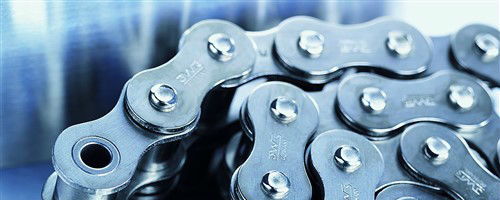Troubleshooting for roller chain and applications
|
PROBLEM |
POSSIBLE CASES |
ANSWER |
| Chain climbing or jumping off the sprocket teeth | Chain or sprockets worn |
Replace the chain and sprockets if necessary |
|
Chain excessively slack |
Adjust the center distance or introduce a jockey sprocket to take up the slack. If allowable, shorten the chain |
|
| Insufficient chain wrap |
For large raito drives the driver sprocket may not have enough teeth to absorb the working tension. If the drive cannot be altered, introduce a jockey sprocket to increase the chain wrap |
|
|
Foreign material build up in the sprockets tooth gaps |
Clean the sprocket teeth of all material so that the chain engages correctly |
|
|
Chain Drive Running Hot |
Lubrication method or type of lubrication is unsuitable for the operating speed and power being transmitted |
Check the catalogue selection tables for the correct lubrication method |
|
Insufficient lubrication |
Increase the frequency of lubrication in line with good maintenance practice |
|
| Chain continually hitting an obstruction |
Remove the obstruction |
|
| Incorrect chain size selected for the speed and transmitted power |
Check the chain selection as a smaller pitch or multistrand chain of equivalent capacity may be required |
|
|
Chain elongation (A gradual increase over its life is normal) |
Lubrication failure | Replace chain and sprockets |
| An overload | Check lubrication, drive configuration and loadings | |
| Displacement of the bearings | Monitor drive elongation over a period of 2-3 months by checking the degree of sag | |
| Failure of the tensioning device | Contact our technical staff for advice if problem persists | |
|
Chain stiffens, starts to whip |
Worn chain or sprockets | Replace chain and sprockets |
| Excessively slack chain | Adjust centres if possible or introduce a take-up system such as a jockey sprocket. it is also possible to shorten the chain by one or more pitches | |
| Heavy & impulsive load | Reduce the loading | |
| Centre distance too long | Add a jockey sprocket on long centre distances | |
| One or more stiff joints |
Remove or repair stiff joints |
|
|
Excessive noise |
Misalignment of sprockets |
Misalignment introduces abnormal loading and wear. Recheck alignment to maintain normal drive conditions |
| Inadequate lubrication | Improve the lubrication method to ensure the proper amount of lubrication is available in the bearing areas | |
|
Worn or incorrectly fitted bearings |
Replace or correct the bearings as these will malign the entire drive |
|
|
Chain excessively slack or tight |
Adjust the centre distance if possible or introduce a jockey sprocket | |
|
Worn chain or sprockets |
Replace the chain and where necessary the sprockets. Consider hardened teeth | |
| Tight joints | Replace or repair joints | |
| Heavy impulsive loads | Reduce the load or introduce a jockey sprocket | |
| Chain pitch size too large | Check the chain selection or contact our technical staff | |
| Obstruction in the chains path | Remove the obstruction | |
|
Heavy wear on sprocket Teeth working faces. (A bright polished appearance Is normal) |
Poor lubrication |
Improve the method of lubrication, (see lubrication section) |
|
Presence of abrasive |
Check for presence of foreign materials and eliminate the source. Replace sprockets and chain if necessary |
|
|
Pin fails |
System loading is greater than the capacity of the chain |
Check the kilowatt rating table to determine if the chain capacity has been exceeded. Larger pitch chain or a multistrand chain may be required if the load conditions cannot be corrected |
|
Roller or bush fails |
Chain capacity has been exceeded at high speed causing impact on the sprocket teeth |
Check the drive selection. A smaller pitch chain, a multistrand chain or sprockets with more teeth may be required |
|
Tooth marks on the outside of the roller diameter can initiate failure |
If the rollers are marked by the sprocket teeth, adjust the centre distance |
|
|
Rust present on chain |
Inadequate lubrication. This will also affect the joints which will be discoloured, (light to dark brown) and could be rough, grooved or galled |
Remove several joints and check that the components are not severely damaged. Replace chain and sprockets as necessary Improve lubrication method |
|
Side plate fails |
Fatigue failure is caused by repetitively loading the chain above its limit |
Check the drive selection, a larger pitch chain or a multistrand chain may be required |
|
Impulsive drive conditions can also cause fatigue failure |
If not the above, check for excessive slack. This may indicate worn chain and sprockets. Replace where required |
|
|
Side plates are worn |
Wear on the inside of the plate is caused by sprocket misalignment |
Check and adjust sprocket and shaft alignment |
|
Wear on the top of the side plate is caused by the chain rubbing against the chaincase or some obstruction |
Remove source of rubbing by removing the obstruction or adding a jockey sprocket to control the slack in the chain |
|
|
Wear on the sides of the sprocket teeth |
Drive misalignment |
Check and correct sprocket and shaft alignment |


Comment